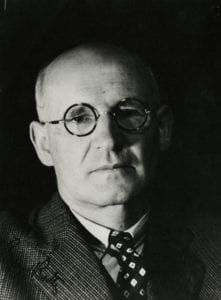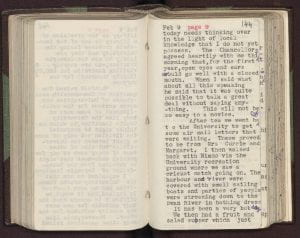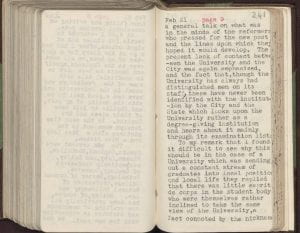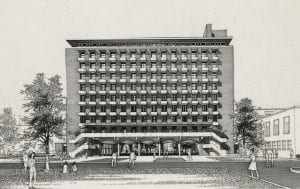More than a “Degree Shop”
Ravando
Despite his short period (1935-38) in Melbourne, Sir Raymond Priestley made significant reforms at the University of Melbourne. As the first salaried Vice-Chancellor, his boldness and visionary ideas completely changed the direction of the University during the tumultuous years of the 1930s and established his prominence as the country’s most charismatic, enigmatic, and invigorating educationist. Many stories and achievements shine through his diaries.

His nomination as Vice-Chancellor in 1934 was advertised broadly before his arrival, particularly in Australia newspapers and was much anticipated for his fame as an arctic explorer preceded him.[1] On his way to Melbourne, when the ship docked at Fremantle, Priestley had an opportunity to meet Sir Walter James, the Chancellor and the Director of Education at the University of Western Australia; and also in Adelaide, he met Prof. Robert William Chapman, the Acting Vice-Chancellor of the University of Adelaide. From both meetings, Priestley notes in his diary on February 9, 1935, p.9 that he would need to have ‘open eyes and ears,’ but a closed mouth for his first year in Melbourne. Priestley admits he was ‘a novice’, and particularly lacking in local knowledge, but wonders how he will get by with invitations to speak publicly befitting his new role. The advice from Chapman was ‘to talk a great deal without saying anything’. He was, however, soon to change his opinion.

It is evident from these carefully typed diaries that Priestley intended to inform his readers of the wide range of his Australian experiences. They cover matters like the state of the Australian university system, social and political events, his wishes for the role of Vice-Chancellor, as well as personal family matters. Interestingly, they were never intended to be private documents, as he revealed in 1937 that the diary was written for two audiences: his family in England and his Cambridge colleagues.
They also provide an overview of the University from the top and record Priestley’s vigorous attempts to reform the University during the post-Depression era.[2] It is worth recalling that recovery from the Depression began around 1932 but had impacted severely on employment opportunities and business confidence. He considered that some of the main difficulties with the University were its financial turmoil over a long time and the students’ pragmatic mindset towards the University. Melbourne’s elite society were so bold as to call the University a ‘degree shop.’

“[T]hough the University has always had distinguished men on its staff, these have never been identified with the institution by the City and the State which looks upon the University rather as a degree-giving institution and hears about it mainly through its examination list.” (Priestley Diaries, 21 February 1935)
Backed by influential reformers, Priestley’s principal initiatives were to connect the University to the people of Melbourne by approaching wealthy industrialists and businesspeople to convince them of the necessity to support the University. Meanwhile, following years of economic recession in Victoria, Priestley also persuaded the state government to increase budgets for the University.
On 28 February 1935 he records that the University was a community of around 4,000 students and 85 full-time professors and lecturers. He posited that a different spirit could be fostered and accomplished by the provision of new infrastructure to make a social space for students and the opening of the students’ Union House on 6 April 1938 was perhaps his most significant success.[3] Moreover, Priestley fought hard for scholarships, more staff, more research, and a new library.
Priestley’s highest aspiration follows John Henry Newman’s argument made in 1852 that The Idea of a University must be the home of free thought, a concept that many members of Council found difficult to perceive. The debates on this issue of the University’s higher purpose led Priestley to his early resignation in June 1938. He left for the University of Birmingham where he became Principal and Vice-Chancellor.
Despite his brief tenure, Priestley’s presence was essential to the development of many features of the present Melbourne University’s culture and governance. Under Priestley’s guidance and administration, ‘the University of Melbourne was dragged, reluctantly, into the 20th century.’ Priestley successfully forced the University to become less ‘a place apart’ and more involved with the society in which it belonged. [4]

To commemorate Priestley’s contributions to the University, the Vice-Principal of the University of Melbourne, Dr. Raymond D. Marginson, decided to name the large ‘slab block’ administration building houses after his name in 1969. The building is currently used as the University’s administrative headquarters and has become a permanent reminder of Priestley’s administrative prowess and vision.
Ravando is a PhD student in the School of Historical and Philosophical Studies at the University of Melbourne. His thesis examines Chinese-Indonesian newspaper called Sin Po (1910-1965) as a lens to explore political movement and transnational connection of Chinese-Indonesian society in the Dutch East Indies (which was later known as Indonesia).
References
[1] See The Herald, 26 July 1934; The Mercury, 28 July 1934, Daily Examiner, 13 August 1934.
[2] For more information on this Great-Depression era see Robert Murray, The Making of Australia: A Concise History. (New South Wales: Rosenberg, 2014); C.B. Schedvin, Australia and the Great Depression: A Study of Economic Development and Policy in the 1920s and 1930s. (Sydney: Sydney University Press, 1970); and http://www.nma.gov.au/online_features/defining_moments/featured/great-depression
[3] The news of the opening can be read in The Herald, 6 April 1936; The Age, 7 April 1938.
[4] Fay Woodhouse, “A Place Apart? A Study of Student Political Engagement at the University of Melbourne 1930–39,” PhD thesis, Department of History, University of Melbourne, 2001.
Leave a Reply